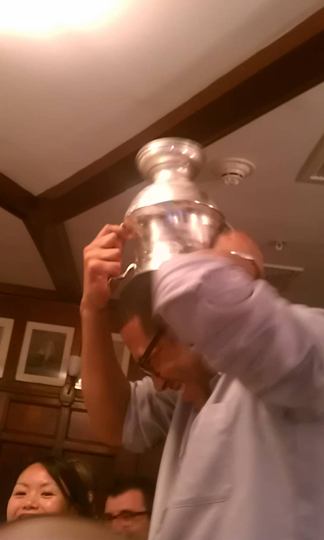Blog
Business Perspectives for Creative Leaders part 4 of 7
My experience attending AIGA & Yale’s School of Management course Business Perspectives for Creative Leaders.
Fair warning: I’ve been drinking – a lot. AIGA and Yale’s Business Perspectives for Creative Leaders course is NOT like any educational experience you will ever have at ANY university. We’re on Fantasy Island here folks. This is a place where you drink from, then spin a giant silver cup on your head. There are Spizzwinks here. The caramel popcorn here has bacon in it. This is a place where you study manufacturing principles by building sail boats out of Bristle Blocks. Here kindly old professors make the entire class sing Who Let the Dogs Out and then suddenly start stripping in the middle of the lesson – for realism. This isn’t education it’s performance art. They need to take this course to Broadway. I am easily laughing as much as I’m learning. I would like to give a shout-out to our “Mr. Roarke” of this Fantasy Island – Mr. Steven Permut. He has the enthusiasm of a 12 year old on Christmas morning. His energy is infectious. Thank you. You’re my boy Blue! (I did say I was drinking earlier right?)
Ok, a few photos, then let’s get to the k-nowledge.
Here are the Spizzwinks; Yale’s oldest underclassman a cappella group. They sang to us during dinner.
This is Mory’s Cup – one of many such large silver cups. It’s filled with some crazy mixed drink.
Once the cup has been picked up, it cannot be put down until it’s empty. It’s passed around the table and everyone takes a turn drinking from it. I think our table drank six of them – along with our beer and wine.
Who ever finishes the cup must lick the entire rim three times, then spin the cup on their head three times. Finally, they slam the cup onto the table upside down. If a single drop of alcohol is left on the table, they have to pay for a new cup!
This is Arthur Swersey. This is him after he stripped out of his suit down to these surgical scrubs. The case study he was explaining was about a hospital’s service model. I wonder how my classmates sitting in the front row felt when he started unbuckling his pants.
I do apologize for the quality of all my photos in this series of posts. I’m only using my cell phone. I figured you’re not really reading these posts for the images anyway right?
Now, today’s lessons will not translate quite so easily into neat bullet points of insight like yesterday’s classes. Today we studied the concepts behind what’s known as LEAN manufacturing and we got started on the first part of our accounting classes. We will be finishing those up tomorrow. So… I only have a few thoughts that passed into my mind as I was sitting in class. And I’ll also recommend some reading that might help you consider the knowledge this course considers important to our businesses.
First, try to think of your business (selling design services) as a product manufacturing plant. Instead of building cars, you’re building websites. How does the project flow through your organization? Who does quality checks? Are your employees specialists or can they do several jobs? Are there bottle necks in your process? Are some parts of your company over-producing with the anticipation of need? Lean manufacturing suggests that you only do work the moment it’s needed. How can you get faster? If you’re working with vendors like photographers and copywriters, how can you shift more of the work burden onto them? Can the copywriter populate the website with their copy?
You should do some reading on Poka Yoke systems. It’s all about building systems through design that “fool-proof” the results. A good example is a camera’s SIM card which can only be put into a camera one way. As designers we have lots of opportunities to “fool-proof” our clients products and websites. But it takes extra thought.
Toyota became a great company because they had such amazing quality. It was built into their culture. Anyone on a Toyota assembly line can shut it down with the pull of a cord if they found a flaw. This kind of power put a lot of pressure on everything to be extremely high quality. Because even one defect could shut down their entire plant. But they also had great quality because they built it into their systems. A good system demands and ensures a good outcome.
Demand for your services are not consistent. Of course it would be great if you could build one website a month and each month on the first of the month a single client called you with a web dev project. But that’s absolutely not how it happens. Instead, you’ll get three projects in one month, then none for a month or two. Consider what you do when three arrive at once? What can you do while you’re idle so you can work faster when those rushes arrive? Is it possible to pre-build certain re-usable parts of a website in advance?
Suggested Reading:
Here is an article I found about applying LEAN to the service industry from Harvard Business School
- The Toyota Way by Jeffery K. Liker
- Lean Six Sigma for Service by Michael L. George
Here are some other books that have been discussed amongst the “students.”
- The Design of Business: Why Design Thinking is the Next Competitive Advantage by Roger L. Martin
- The Brand Gap: How to Bridge the Distance Between Business Strategy and Design by Marty Neumeier
- Chief Culture Officer: How to Create a Living, Breathing Corporation by Grant McCracken
- Buy-In: Saving Your Good Idea from Getting Shot Down by John P. Kotter
Thanks to Mark Badger for putting this list together.
I’m so tired. More tomorrow!





